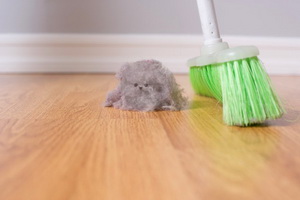
Allergy is an increased sensitivity to various substances, manifested by unusual reactions in contact with them. Almost everything that surrounds us can become an allergen. Even if you disappeared at home from spring pollen, this does not mean that you ran away from allergies.
Allergy to house dust
Any home dust is a complex of allergens. It includes: library dust (cellulose), fragments of feathers, wool and dandruff animals, woolen fibers, hair and human skin particles, spores of mold fungi and bacteria, particles of insects (cockroaches), cotton, upholstery for furniture, etc. All of the above may be the cause of an allergic disease, but the main household allergen is a house dust mite. The main symptoms of allergy to household dust are:
Shortness of breath (shortness of breath, suffocation); - wheezing in the chest; Spastic (paroxysmal) non-productive cough; Nasal congestion, watery discharge from the nose, sneezing; Itching and redness of the eyes, lacrimation; Symptoms of eczema or hives. These symptoms are especially evident at night in bed and in the morning on waking, when cleaning in rooms. Symptoms are noted all the year round and are especially disturbing in the autumn and winter, when the mites reproduce. The peak of abundance is at the end of August - beginning of October.
Allergy to mold
Allergy associated with mold fungi, for the most part, occurs during the season of the greatest spread of fungal spores; This is the warm season - from June-July to September-October.
Symptoms of allergies develop by inhaling microscopic spores or fragments of fungi that are easily transported by air:
Difficulty breathing (gasps, dyspnea); Cough; Nasal congestion, sneezing attacks. When fungi enter the stomach, the following symptoms may occur: Pain in the stomach, Diarrhea, nausea, vomiting; Itching in the oral cavity, angioedema; Hives. The place of growth and reproduction of mold fungi are warm, damp, poorly ventilated rooms, cooling and heating systems, air conditioners, air cleaners above the plates, dishwashers. Mushrooms grow on wallpaper, walls in the bathroom and toilet, indoor plants, in the trash can and garbage containers. The moist soil of the flower pot is a good environment for the development of mold fungi.
Allergy to insects
Symptoms of allergies occur when inhaling small particles of insect bodies or products of their vital activity, bites and stings. Allergies can occur on the bites of blood-sucking insects (mosquitoes, midges, horns, bugs) and on contact with other insects (cockroaches, moths, butterflies, grasshoppers, etc.). Allergens of cockroaches are present in house dust. The most dangerous type of allergy is allergic to stinging by Hymenoptera insects (wasps, bees, etc.).
A typical and normal reaction in people after stinging is pain, swelling and redness, which are confined to the place of stinging. Less often the local reaction can be more pronounced, and it consists in considerable edema and soreness. Although this reaction is rather unpleasant, it usually lasts no more than 2-3 days. Allergy to latex Allergy to latex can occur at various times from the beginning of everyday contact with latex - a few days, months or years. Particularly allergies to latex are subject to doctors and food industry workers using latex gloves, and people using condoms, which include latex.
For allergy to latex, the most common are various skin symptoms that occur after contact with products containing latex, such as hyperemia, itching, swelling, or blisters. Latex particles can be transmitted through the air, then there are symptoms of respiratory allergies - sneezing, runny nose, lacrimation, itching and redness of the eyes, choking attacks are possible.
Allergy to household chemicals
This type of allergy is spreading more and more every year, as the products of household chemicals improve. It is manifested by skin reactions: itching, redness, peeling of the skin at the point of contact with the substance, as well as respiratory symptoms by inhaling particulate matter.
Which exactly allergens cause the disease is determined by means of so-called skin tests. On the back of the forearm put different allergens and a thin needle slightly prick the skin. After a while, evaluate the reaction: if the skin flushed and there was swelling, then the body is sensitive to this substance.


